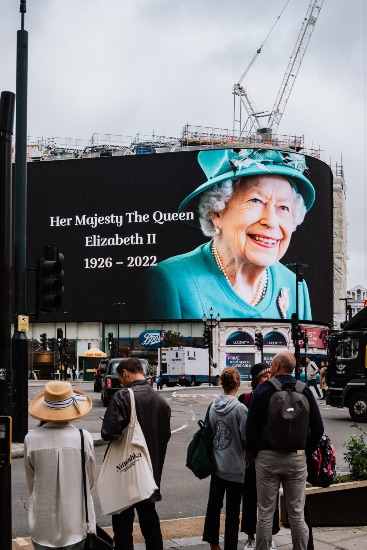On the 8th of September, Buckingham Palace announced that the Queen, Elizabeth II, had passed away “peacefully” at her residence in Scotland. That afternoon and the following day, Britain and many nations worldwide would pay tribute to her figure and honor her legacy. Because of the longevity of her reign and the interest that she awakened in younger generations, her death was a motive for mourning for countless people.
The popularity of the Queen has a lot to do with her relationship with the media. Since her coronation in 1953, media outlets have played a crucial role in creating the branding around the House of Windsor and projecting its name internationally. Before her passing, YouGov had surveyed UK citizens to know the popularity of British royals. The results showed that among all the family members, the monarch was the one who the public held in the highest regard. However, this visibility has not always benefited her image since, in the same poll, there was evidence of media exposure’s damage to other royal’s reputations. For example, back in 2021, millions of viewers tuned in for an unprecedented interview that the Duke and Duchess of Sussex gave about their “royal life.” The declarations during the exchange were controversial; for many, it resulted in one of the biggest reputational crises that the British Monarchy had to endure. Nevertheless, despite the incident and other scandals, the Queen remained admired globally.

So, how has the media been honoring her late figure? After confirming the announcement, many Tv stations canceled their schedules and started live streams updating information minute by minute. National newspapers such as
the Times, the Guardian, and the Daily Mail launched special editions with long spreads, which set the tone for the global media to follow. Soon after, some articles reported more than 400 pages of coverage regarding the Queen’s death in British newspapers alone. Internationally, other publications contributed to engrossing these numbers with extensive papers. And at the same time, digital platforms echoed the news, too.
However, what is interesting about this overwhelming media coverage is how it has transformed within a week. What started as a memorial expressed through unity and grief has also given bizarre tributes that have taken over communication channels. Diverse trends have emerged in digital sites, where users have been both witnesses and participants in creating content related to the sovereign’s death. On TikTok, for example, some users have claimed to have spotted a Queen-shaped cloud moments after her passing, and such clips have generated more than 40 million views on the platform. As a result, a growing audience has declared that content saturation has become a nuisance since it is more complex to update on further “real” news. Thus, the “information fatigue” is damaging the media and its audience because while the first is more eager to find a new angle of the story that hasn’t been exhausted, people become less invested in the news.
Despite the transcendence of the event, the emotion has worn off as time goes on. Still, a new topic of interest for media researchers is the steps that the next sovereign, Charles III, will take to project his image. His relationship with the media has been tumultuous so far, so the public doesn’t hold an opinion as favorable as his mother gained during her reign. In addition, he is about to become the first monarch to ascend to the throne in an era of “influencers,” “memes,” and “trending topics,” which makes it more difficult to change perceptions about him. Yet, the new monarch will have to be able to leverage these new forms of content.
Media and Monarchy shared a fragile balance of power and attention that in the past benefited both. On the one hand, the Monarchy required media outlets to contact audiences; on the other hand, the media was avid in fueling the fascination that royals woke in society. However, the circumstances have changed, and this relationship isn’t as stable as it used to be. Monarchy has remained the same, while communication channels have changed heavily. It is up to the new sovereign to acknowledge it, adapt to an environment more connected, and represent an institution that seems more distant to younger generations. What is clear is that the death of Elizabeth II could suppose a turning point for change in the British Monarchy.

